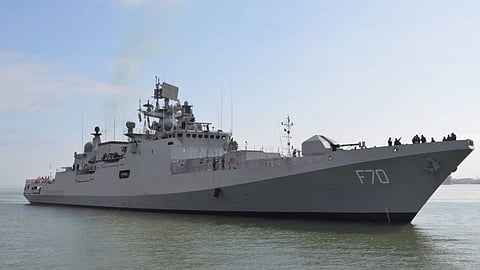VESSEL REVIEW | INS Tushil – Indian Navy welcomes new stealth frigate into service
The Indian Navy has taken delivery of a new guided-missile frigate built by Yantar Shipyard in Kaliningrad, Russia.
INS Tushil (named after the Sanskrit word for “Protective Shield”) is the seventh frigate to be built under Project 11356, otherwise known as the Talwar-class. Another frigate, the future INS Tamala, is scheduled to be handed over to the Indian Navy in the first quarter of 2025.
Variants of an earlier proven Soviet warship design
Design work on the Talwar-class frigates was undertaken by Russian engineering firm Severnoe Design Bureau. The Indian ships are upgraded variants of the Project 1135 or Krivak-class frigates that were introduced into service with the Soviet Navy in the 1970s.
Tushil and Tamala are themselves upgraded follow-on ships to the six original Talwar-class frigates and were designed and built in fulfilment of a 2016 contract between the Indian government and Russian state-owned military materiel exporter Rosoboronexport.
Multi-role stealth platform
The two new frigates were originally built as additional examples of the Project 11356R or Admiral Grigorovich-class for the Russian Navy but the decision was made to supply the ships to India instead.
Although built in Russia, the newer Talwars have at least 25 per cent Indian content, which includes some of the weaponry, communications gear and target detection sensors. Capable of blue water operations, the frigates will perform missions that include anti-air warfare, anti-surface warfare, anti-submarine warfare, and electronic warfare.
Tushil has a length of 124 metres (407 feet), a beam of 15 metres (49 feet), a draught of 4.5 metres (15 feet), a displacement of approximately 4,000 tonnes, and a crew complement of 180.
The ship also boasts advanced stealth features and four Zorya-Mashproekt gas turbines in a combined gas and gas (COGAG) arrangement that delivers a top speed of 32 knots and a range of 4,850 nautical miles.
The vessel’s broad array of armament includes eight BrahMos land attack and anti-ship missiles, 24 Shtil-1 and eight Igla-1E surface-to-air missiles, a 100mm naval gun, two AK-630 30mm close-in weapon systems, anti-submarine rockets, and torpedoes launched from 533mm tubes.
Fitted with aviation and self-protection systems
Hangar and flight deck facilities are available for use by a Ka-28, Ka-31, or Dhruv helicopter for utility, early warning and anti-submarine duties while a decoy launcher provides added protection against hostile missiles.
Tushil departed Kaliningrad in the middle of December 2024 for its delivery voyage to India. The frigate’s transits covered the Baltic Sea, the North Sea, the Atlantic Ocean, and the Indian Ocean, and it made port calls and conducted joint exercises at a number of friendly foreign countries along the way.
Following its arrival in India, Tushil will join the Indian Navy’s Western Fleet headquartered in Mumbai.


